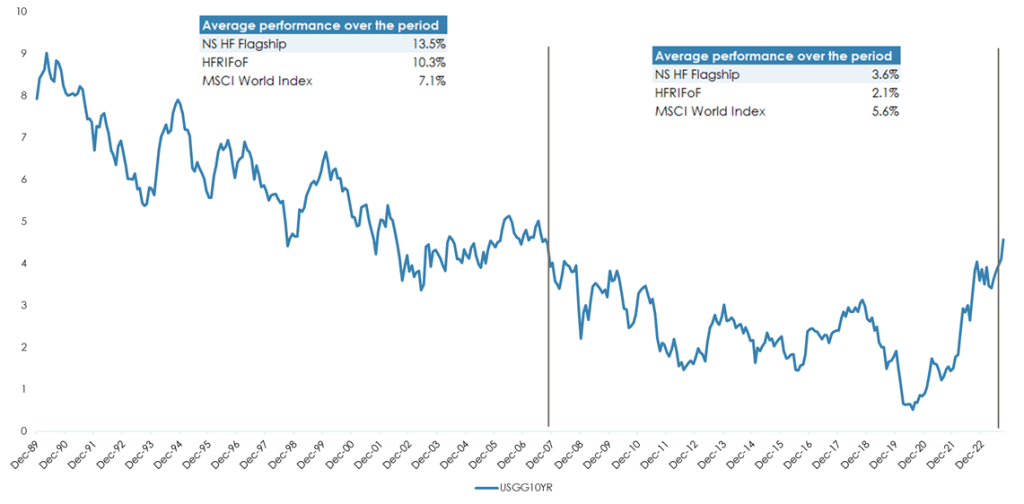Chart of the Month – The game changer

October saw further deterioration in market sentiment with rising geopolitical tensions. Another concern was the rising US debt supply, pushing long-term yields above 5%. Last month, the MSCI World Index was down 3.0% and since the peak in July, global equity markets lost 9.7%.
Despite this recent correction, markets are still up for the year. A resilient economy, especially in the US, surprised many investors and made the soft-landing scenario the most likely one. Overall, corporate earnings have been strong. Nevertheless, looking behind the surface, the situation looks potentially more challenging. The MSCI World equally weighted index is down 1.8% this year. Investors are realizing that rates could remain higher for longer.
This chart shows the evolution of the US 10-year bond yield since 1990. We had a great bull market for more than 30 years and the 10Y went down from 9% to less than 1% when the COVID pandemic hit. Following the huge liquidity injections made by central banks, inflation started to rise in 2021 and central banks started to raise rates again. The cost of capital increased significantly over the last 18 months. Since then, market participants have tried to adapt to this new reality but the impact on economies and corporates is just starting to be felt.
What could we expect from hedge funds in this context?
- Short-term, long/short equity managers are defensively positioned and making money on shorts and global macro managers are up playing the steepening of the yield curve.
- Longer-term, looking at the chart, historical data shows that hedge fund managers perform best in higher interest rate regimes. During the period between 1990 and 2007, when rates were above 4%, hedge funds outperformed markets by 3.2% on average if we consider the HFRI FoHF Composite index. Our selection of hedge funds even outperformed markets by 6.4%. Since 2008 and the GFC, rates have remained below 4% and hedge funds underperformed markets. Our selection of hedge funds underperformed markets by 2% even if the result is clearly better on a risk-adjusted basis.
The situation has changed and the 10Y, which recently reached 5%, could remain above 4% for some time. Inflation is likely to remain higher and huge deficits are expected going forward with the combination of deglobalization, energy transition, the US election and lack of buyers.
Hedge fund returns are a function of dispersion in equity markets, and higher rates help separate the winners from the losers. In addition, short-term zero rates had neutralized one of the key sources of returns for the strategy. Today with 5% rates, just because of keeping a relevant short book, a manager can basically pay for its own fees with interest gained on its shorts. Finally higher macro and market volatility, creates an environment rich with opportunities for active trading.
A hedge fund allocation on your client’s portfolio makes sense in this current investment régime.
Past performance is not indicative of future results. The views, strategies and financial instruments described in this document may not be suitable for all investors. Opinions expressed are current opinions as of date(s) appearing in this material only. References to market or composite indices, benchmarks or other measures of relative market performance over a specified period of time are provided for your information only. NS Partners provides no warranty and makes no representation of any kind whatsoever regarding the accuracy and completeness of any data, including financial market data, quotes, research notes or other financial instrument referred to in this document. This document does not constitute an offer or solicitation to any person in any jurisdiction in which such offer or solicitation is not authorized or to any person to whom it would be unlawful to make such offer or solicitation. Any reference in this document to specific securities and issuers are for illustrative purposes only, and should not be interpreted as recommendations to purchase or sell those securities. References in this document to investment funds that have not been registered with the FINMA cannot be distributed in or from Switzerland except to certain categories of eligible investors. Some of the entities of the NS Partners Group or its clients may hold a position in the financial instruments of any issuer discussed herein, or act as advisor to any such issuer. Additional information is available on request.
© NS Partners Group